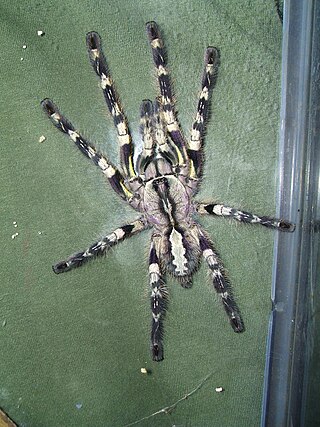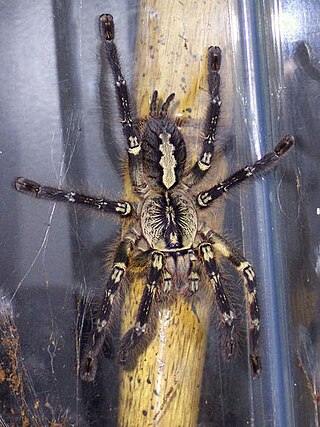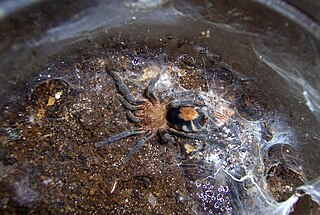
Poecilotheria metallica, also known as the peacock tarantula, is an Old World species of tarantula. It is the only blue species of the genus Poecilotheria. Like others in its genus it exhibits an intricate fractal-like pattern on the abdomen. The species' natural habitat is deciduous forest in Andhra Pradesh, in central southern India. It has been classified as Critically endangered by the IUCN.
Stromatoxin is a spider toxin that blocks certain delayed-rectifier and A-type voltage-gated potassium channels.

Poecilotheria regalis is a species of arboreal tarantula and is found in parts of India. The common name for this spider is Indian ornamental tree spider, or simply Indian ornamental. It is one of the most popular arboreal tarantulas for amateur collectors. Their leg span sometimes exceeds 7 inches (18 cm).

Tarantulas comprise a group of large and often hairy spiders of the family Theraphosidae. As of December 2023, 1,100 species have been identified, with 166 genera. The term "tarantula" is usually used to describe members of the family Theraphosidae, although many other members of the same infraorder (Mygalomorphae) are commonly referred to as "tarantulas" or "false tarantulas". Some of the more common species have become popular in the exotic pet trade. Many New World species kept as pets have setae known as urticating hairs that can cause irritation to the skin, and in extreme cases, cause damage to the eyes.

Psalmopoeus cambridgei, the Trinidad chevron tarantula, is a species of spider in the family Theraphosidae, endemic to Trinidad. Its venom is the source of psalmotoxin and vanillotoxin which are classified as inhibitor cystine knot proteins. Psalmotoxin may be of therapeutic use in patients with a stroke.

Poecilotheria ornata, known as the fringed ornamental or ornate tiger spider, is a large arboreal tarantula, which is endemic to Sri Lanka. Their legspan sometimes reaches 10 inches (25 cm) in females, and is probably the second largest of the genus, behind Poecilotheria rufilata.

Stromatopelma is a genus of African tarantulas that was first described by Ferdinand Anton Franz Karsch in 1881. They are renowned for their potent venom that uses stromatoxin peptides to induce medically significant effects.

Aphonopelma moderatum is a species of spider in the family Theraphosidae, found in United States, in the state of Texas. Commonly called the Rio Grande Gold Tarantula as they are found in the Rio Grande Valley of Texas.

Encyocratella is a monotypic genus of Tanzanian tarantulas containing the single species, Encyocratella olivacea, also known as the Tanzanian black and olive baboon spider. It was first described by Embrik Strand in 1907, and is found in Tanzania.

Avicularia minatrix also known as the Red Slate Pink Toe, Redstripe Pinktoe or Venezuelan Redstripe Tarantula is a species of spider in the family Theraphosidae, found in Venezuela and Brazil. It was first described by Reginald Innes Pocock in 1903, being arboreal in nature and quite reclusive, and also the smallest tarantula of the Avicularia genus.

Caribena laeta, otherwise known as the Puerto Rican pink toe tarantula, is a species of spider in the family Theraphosidae, found in the US Virgin Islands, Puerto Rico, and Cuba, the last dubiously according to Caroline Fukushima and Rogério Bertani in 2017. It was first described by Carl Ludwig Koch in 1842 under the name Mygale laeta.

Tapinauchenius plumipes, the orange tree spider, is a tarantula endemic to French Guiana. It was first described by Ludovico Di Caporiacco in 1954. Its previous name, Tapinauchenius gigas was based on the Latin word for giant, being gigas. This tarantula is often kept as a pet and commonly bred.

Chilobrachys fimbriatus, commonly known as the Indian Violet Earth Tiger Tarantula usually shortened to Indian Violet Tarantula, is a species of spider of the genus Chilobrachys. It is endemic to India, and was first described by Reginald Innes Pocock in 1899.

Thrixopelma ockerti, commonly known as the Peruvian Flame Rump or Flame Rump Tree Spider, is a species of tarantula and the type species of the genus Thrixopelma. It is endemic to Peru and was first described by Gunter Schmidt in 1994. It is named ockerti after the collector Roland Ockert.
Pterinochilus lugardi also known Grey starburst baboon, Dodoma baboon, Fort hall baboon or Tanzanian blonde baboon tarantula is a tarantula first described by Reginald Innes Pocock in 1900. They are found all over Southern and Eastern Africa, of course excluding Madagascar.

Harpactira cafreriana otherwise known as the Cape copper baboon or amber baboontarantula spider was first described by Charles Athanase Walckenaer in 1837. It is found in South Africa, being terrestrial or semi-fossorial in nature.

Cyriocosmus perezmilesi otherwise known as the Bolivian dwarf beauty tarantula is a spider which was first described by Radan Kaderka in 2007. It was named in honor of Dr. Fernando Pérez-Miles, and is a fossorial tarantula. As its common name aptly states it is found in Bolivia.
Augacephalus ezendami is a tarantula found in Mozambique, it was first described by Richard C. Gallon in 2001. It is named after Thomas Ezendam, whom provided Gallon with numerous specimens.
Heterothele gabonensis, also known as the Gabon blue dwarf baboon tarantula, is a species of tarantula found in Gabon. It was first described by Pierre Hippolyte Lucas in 1858, under the name Mygale gabonensis. They are semi arboreal tarantulas, that web quite a lot. They have also showed some communal tendencies in the form of tolerance for one another over an extended period of time.

Hapalopus formosus, also referred to as Hapalopus sp. Colombia or pumpkin patch tarantula, is a tarantula, first described by Anton Ausserer in 1875. It is found in Colombia.
















